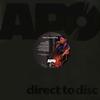 Chris Thomas King Chris Thomas KingEssay: New Orleans Music, Direct-to-Disc www.ChrisThomasKing.com 5 December 2014 A Vinyl Musical Postcard of New Orleans Music The other night I was hosting some friends from out of town. I was playing tour guide to the "real" New Orleans—beyond Bourbon Street— as we locals would have it. While we were passing time for an hour wait for dinner at the popular Carrollton neighborhood restaurant Jacque-Imo's, we walked to a nearby sushi bar for drinks. The gentleman sitting next to us said hello, and without pause, began raving about bassist, George Porter Jr., who was due on stage at the Maple Leaf next door around midnight. The gregarious gentleman ran off a list of clubs my guests should visit and bands they should see. Then he said one band in particular sounded special because, "they use gated microphones!" There were blank stares on the faces of my guests. After a puzzled pause, one asked, "What is a gated microphone?" As the friendly gentleman began to explain the technicalities, my mind wondered. I began thinking about a call I received from producer Chad Kassem, of Analogue Productions, in the autumn of 2013. I was asked to travel to Kansas to record Direct-to-Disc—not to be confused with today's computer hard drives. I wistfully thought of that scene in O Brother Where Art Thou, wherein, as one of the fictional Soggy Bottom Boys, I was asked to sing into a can by a frayed sightless old record man. The can was a protruding tinhorn attached to a gramophone. During a typical old-time recording session, sound waves would emanate through the tinhorn and vibrate the gramophone stylus, which would then etch a musical groove into a rotating wax disc, instantly creating a phonograph record. Direct-to-Disc as the process became known, predated the use of tape and was standard procedure by the 1930s. The Kansas session would be an extraordinary experience. I was intrigued to say the least. I must admit I'm neurotic about the recording process. In my studio, which is equipped with analog gear as well as today's industry standard Pro Tools; I can easily accommodate over 100 tracks of digital recording. The problem I often have is too many choices. Sometimes it takes weeks for me to decide which plectrum to use with which microphone. After testing every microphone and plectrum combination in my studio, I occasionally lose the original inspiration and excitement I first had when I began the process. An inspired performance is essential for anyone to create a great recording. I seized the chance to leave behind the somewhat paralyzing conundrum of infinite options afforded in the digital recording studio, to become virtually transported back to an unobtrusive immediate analog method. It was a dream come true as if I'd died and gone to blues heaven. As it turns out, that's precisely where the recording session took place, in Blues Heaven Studios, which is located in a venerable converted church, in Salina, Kansas. I have long treasured historic Direct-to-Disc recordings. The Bristol, Tennessee, recording sessions of the Carter Family and Jimmy Rodgers, produced by Ralph Peer, changed the course of music. As did the red-hot blues recordings of Louis Armstrong's Hot Five in Chicago. The Direct-to-Disc recordings by John Lomax—in metropolitan Baton Rouge's Angola State Prison—of Huddie Ledbetter, likewise, have also been significantly influencing. Before these early recordings the only way one could hear these great musicians was to be within earshot while they performed live. My Direct-to-Disc session does not merit such historical significance, but neither did these sessions in real-time. Future generations will ultimately decide its connotations. Nevertheless, it was a delight to document my current New Orleans acoustic folk performance through the purest recording process known today. No retakes, no overdubs, no plugins and—lol— no gated microphones. Only my J-45 Gibson guitar, vocal, and the ethereal reverb from hallowed church walls is etched into the 200-gram vinyl disc. We in Louisiana have a long colorful and influential musical history. Our live music scene has no peers—sorry Austin. However, New Orleans is not well known for capturing great recordings of its native musicians. Visiting artists, from Little Richard to Bob Dylan, have made many excellent recordings in our studios over the years. Furthermore, New Orleans has had some fine studios in the past, such as, J&M and Ultrasonic. Today The Shed is one of our last remaining great rooms. Nevertheless the art of the great studio recording remains elusive to many of us who may have mastered the art of live performance over the years. The most significant recordings of New Orleans music reside in our collective memories, the soundtrack to good times we've had grooving in the cities' joints. Nowhere else could you meet a random stranger in a restaurant and within two minutes you're deep in conversation about a myriad of local bands and “gated microphones.” There is no “gated microphone” or dynamic processing used in my Direct-to-Disc (D2D) recording. My movements and recording techniques controlled all dynamics. By the way, a “Noise Gate” is a dynamic processor that is commonplace in live joints, George Porter, Jr., may have used one on his microphones at the Maple Leaf that night. My guests and I toasted the city and said good-bye to our new friend before enjoying a splendid dinner at Jacque-Imo’s. It was well worth the wait. Although I’m mostly vegetarian, the decadence of our shrimp and alligator sausage cheesecake appetizer, was delightfully luscious. We joint hopped the rest of the night, enjoying dozens of live bands until the wee hours of the morning. My guests left town with an indelible New Orleans soundtrack in their collective memories, which sadly, cannot be shared with their friends back home. My D2D recording would have been the perfect postcard, the next best thing to being there. Notes:D2D (Direct-to-Disc) My new limited vinyl LP (APO Records/Acoustic Sounds) is essentially an offering to my most loyal fans. It is my hope they will experience great listening pleasure from it. I presume record collectors and audiophiles will also be very pleased with the care Blue Heaven's engineers have taken to produce such genuine vinyl results. The LP is now available for order from (acousticsounds.com). I was asked to sing into a can by Blues Heaven Productions on October 17, 2013. They documented a little piece of my heart, and preserved it for music fans all over, and for that I am gratified. |
 In-Stock Music Orders Over $99 SHIP FREE Within The Continental U.S.
In-Stock Music Orders Over $99 SHIP FREE Within The Continental U.S.







 Login
Login
 My Account
My Account
 Cart
Cart Wishlist
Wishlist
 Contact
Contact





